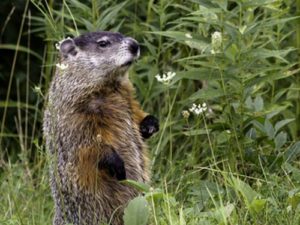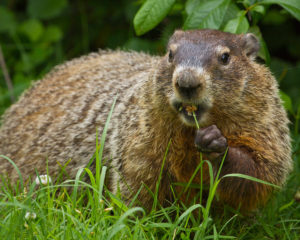Groundhogs
SCIENTIFIC NAME: Marmota monax
TYPE: Mammals
DIET: Herbivores
SIZE: Head and body, 17.75 to 24 in; tail, 7 to 9.75 in
WEIGHT: 13 lbs
SIZE RELATIVE TO A 6-FT MAN:
The groundhog, AKA “woodchuck” or “whistle pig” is primarily active during the daylight hours. Groundhogs are usually brownish-gray with a short tail well covered in dark brown or black fur. The groundhog weights about 5 -10 lbs., average length is 16 – 20 inches long and has a tail 3 – 6 inches long. The groundhog is a rodent with large white or ivory chisel like incisor teeth. The groundhogs compact chunky body is supported by short strong legs. Its fore feet have long curved claws that are perfect for digging burrows. The groundhog is typically shy and runs to the safety of their den or other shelter. The groundhog will stand its ground if needed. The groundhog uses a defensive posture and is known for teeth clicking and false forceful lunges to scare off other critters. Groundhogs are among the few animals that enter true hibernation during winter. Hibernation generally starts in late fall towards the end of October to the middle of November, depending on the weather. After the first frost, the groundhog will retreat to their underground burrows and sleep until spring. The groundhog rarely ventures out in winter. Groundhogs will resurface in late February or March based on weather. Groundhog Day is celebrated annually on February 2nd.
HABITAT / DIET
Groundhogs prefer to construct burrows in open farmland and in wooded brushy areas where it is easy to see predators. In the suburbs they will burrow under sheds, decks, sunrooms, shrub lines, concrete patios/porches and along foundations. The burrow serves as its home for mating, raising young, hibernating and escaping danger. The groundhog burrow can be identified by a large mound of dirt with an entry hole approx. 6 – 8 inches in diameter. The depth of the groundhog burrow is 3 -5 feet with a length of 10 – 25 feet. Usually groundhogs have two entrances to the burrow, but not always. Groundhog burrows or dens can be quite extensive based on the length of time they are at the site. Groundhogs constantly groom their den. Generally, groundhogs roam 50 – 150 feet from their den based on availability of food and water. Groundhogs are frequently seen sun bathing on decks or concrete slabs during the warmest part of the day. Groundhogs are average climbers and can be seen on the lower branches of trees, typically going for food.
The groundhog is an herbivore, a vegetarian. The groundhog feeds on a variety of vegetables, grasses, leafy greens, gardens items such as cabbage, lettuce, kale or spinach, various flowers, ripe tomatoes, and mulberries and fruits. The groundhog primarily feeds in the early morning and evening hours. He is often seen grazing in lawns throughout the daytime or evening hours.
BREEDING
Groundhogs breed in March – April. The male groundhogs come out of hibernation first in mid to late February to early March. The male groundhog begins his search for a mate. After mating with one female some males will search for additional females to mate with while other males will stay at the burrow with his mating female until she forces him away. This occurs before she gives birth. The gestation period for groundhogs is about 32 days. The male groundhog is considered a threat to the young, therefore, the female groundhog drives him away and cares solely for the young. The female groundhog gives birth to a litter size of 2-6 pups. Groundhogs have only one litter per year and the babies are normally born in April or May. By mid to late summer the den becomes over-crowded and the mother groundhog will begin to drive the young off into nearby burrows. She will continue to care for them for several months. As the young groundhogs develop, they leave their mother to create their own territory. As groundhogs relocate, they will inhabit unused groundhog burrows, they may reopen previously filled groundhog burrows, or simply make a new burrow.
DISEASE
Groundhogs can be carriers of rabies but it is rarely an issue. After removal of groundhogs, vacant groundhog burrows / dens should be sprayed with a disinfectant to help minimize the odors or bacteria left behind. The hole should be filled to prevent other wildlife from occupying them in the future.
CONTROL
The most effective control for unwanted nuisance critters such as groundhogs is to trap and remove it from your property. Groundhogs generally don’t leave on their own and repellants and odor deterrents have little or no lasting effect on the groundhog. As the ASAP Critter People say…If you want to get rid of your critter problem…you have to get rid of the problem critter. Our professionally trained technicians will evaluate your critter issue and determine the best method of removal to safely and humanely remove your problem critter. Quality repairs or exclusion methods are a must to avoid future problems. Repairs and prevention services are an important part of the control methods we offer and back with a warranty. For prompt, professional, and courteous service, call family-owned and operated ASAP Critter People at 513-941-0258 today! THE LEADER OF THE PACK!






